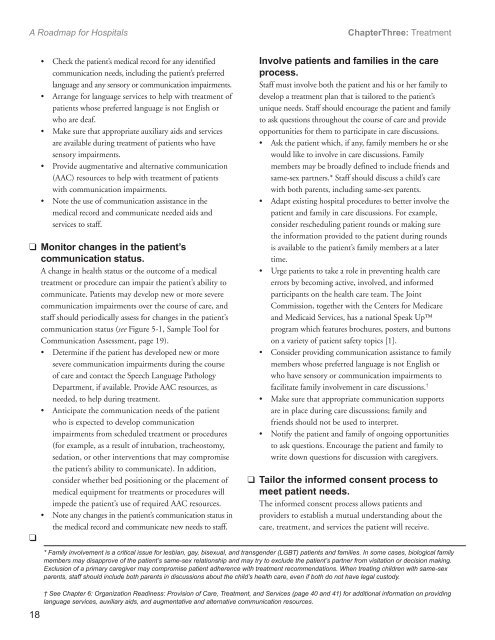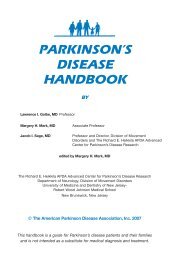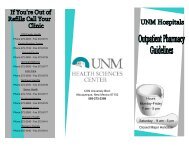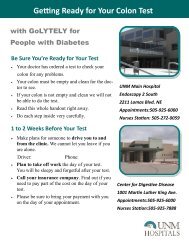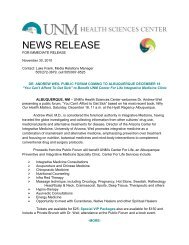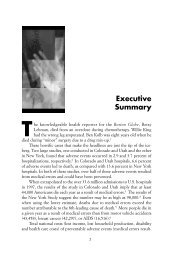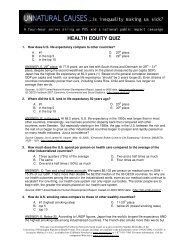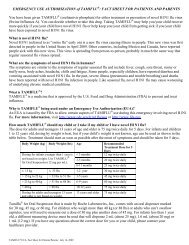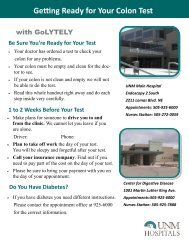Advanced Effective Communication, Cultural Competence, and ...
Advanced Effective Communication, Cultural Competence, and ...
Advanced Effective Communication, Cultural Competence, and ...
Create successful ePaper yourself
Turn your PDF publications into a flip-book with our unique Google optimized e-Paper software.
A Roadmap for Hospitals<br />
ChapterThree: Treatment<br />
18<br />
• Check the patient’s medical record for any identified<br />
communication needs, including the patient’s preferred<br />
language <strong>and</strong> any sensory or communication impairments.<br />
• Arrange for language services to help with treatment of<br />
patients whose preferred language is not English or<br />
who are deaf.<br />
• Make sure that appropriate auxiliary aids <strong>and</strong> services<br />
are available during treatment of patients who have<br />
sensory impairments.<br />
• Provide augmentative <strong>and</strong> alternative communication<br />
(AAC) resources to help with treatment of patients<br />
with communication impairments.<br />
• Note the use of communication assistance in the<br />
medical record <strong>and</strong> communicate needed aids <strong>and</strong><br />
services to staff.<br />
❑ Monitor changes in the patient’s<br />
communication status.<br />
A change in health status or the outcome of a medical<br />
treatment or procedure can impair the patient’s ability to<br />
communicate. Patients may develop new or more severe<br />
communication impairments over the course of care, <strong>and</strong><br />
staff should periodically assess for changes in the patient’s<br />
communication status (see Figure 5-1, Sample Tool for<br />
<strong>Communication</strong> Assessment, page 19).<br />
• Determine if the patient has developed new or more<br />
severe communication impairments during the course<br />
of care <strong>and</strong> contact the Speech Language Pathology<br />
Department, if available. Provide AAC resources, as<br />
needed, to help during treatment.<br />
• Anticipate the communication needs of the patient<br />
who is expected to develop communication<br />
impairments from scheduled treatment or procedures<br />
(for example, as a result of intubation, tracheostomy,<br />
sedation, or other interventions that may compromise<br />
the patient’s ability to communicate). In addition,<br />
consider whether bed positioning or the placement of<br />
medical equipment for treatments or procedures will<br />
impede the patient’s use of required AAC resources.<br />
• Note any changes in the patient’s communication status in<br />
the medical record <strong>and</strong> communicate new needs to staff.<br />
❑<br />
Involve patients <strong>and</strong> families in the care<br />
process.<br />
Staff must involve both the patient <strong>and</strong> his or her family to<br />
develop a treatment plan that is tailored to the patient’s<br />
unique needs. Staff should encourage the patient <strong>and</strong> family<br />
to ask questions throughout the course of care <strong>and</strong> provide<br />
opportunities for them to participate in care discussions.<br />
• Ask the patient which, if any, family members he or she<br />
would like to involve in care discussions. Family<br />
members may be broadly defined to include friends <strong>and</strong><br />
same-sex partners.* Staff should discuss a child’s care<br />
with both parents, including same-sex parents.<br />
• Adapt existing hospital procedures to better involve the<br />
patient <strong>and</strong> family in care discussions. For example,<br />
consider rescheduling patient rounds or making sure<br />
the information provided to the patient during rounds<br />
is available to the patient’s family members at a later<br />
time.<br />
• Urge patients to take a role in preventing health care<br />
errors by becoming active, involved, <strong>and</strong> informed<br />
participants on the health care team. The Joint<br />
Commission, together with the Centers for Medicare<br />
<strong>and</strong> Medicaid Services, has a national Speak Up<br />
program which features brochures, posters, <strong>and</strong> buttons<br />
on a variety of patient safety topics [1].<br />
• Consider providing communication assistance to family<br />
members whose preferred language is not English or<br />
who have sensory or communication impairments to<br />
facilitate family involvement in care discussions. †<br />
• Make sure that appropriate communication supports<br />
are in place during care discusssions; family <strong>and</strong><br />
friends should not be used to interpret.<br />
• Notify the patient <strong>and</strong> family of ongoing opportunities<br />
to ask questions. Encourage the patient <strong>and</strong> family to<br />
write down questions for discussion with caregivers.<br />
❑ Tailor the informed consent process to<br />
meet patient needs.<br />
The informed consent process allows patients <strong>and</strong><br />
providers to establish a mutual underst<strong>and</strong>ing about the<br />
care, treatment, <strong>and</strong> services the patient will receive.<br />
* Family involvement is a critical issue for lesbian, gay, bisexual, <strong>and</strong> transgender (LGBT) patients <strong>and</strong> families. In some cases, biological family<br />
members may disapprove of the patient’s same-sex relationship <strong>and</strong> may try to exclude the patient’s partner from visitation or decision making.<br />
Exclusion of a primary caregiver may compromise patient adherence with treatment recommendations. When treating children with same-sex<br />
parents, staff should include both parents in discussions about the child’s health care, even if both do not have legal custody.<br />
† See Chapter 6: Organization Readiness: Provision of Care, Treatment, <strong>and</strong> Services (page 40 <strong>and</strong> 41) for additional information on providing<br />
language services, auxiliary aids, <strong>and</strong> augmentative <strong>and</strong> alternative communication resources.


